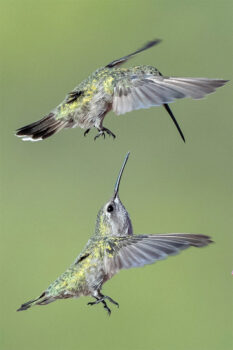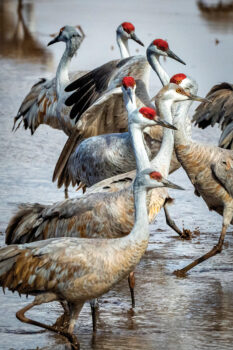
American Wigeons (Photo by Jim Hoagland)

Hummingbirds (Photo by Jim Hoagland)

Sandhill Cranes (Photo by Jim Hoagland)
Jim Hoagland
I guess you could say I became a professional photographer at the young age of 17 working and getting paid (hence professional) by the local newspaper using a Graflex camera with 4 x 5 film holder and burning my fingers whenever I removed the flash bulb. I remember one of the pictures I took was of a “No Swimming” sign with a frozen pond in the background but with a bird’s nest on top of the sign. Little did I know that was the beginning of my “Bird Photography” world. It really took off in earnest on a trip to Belize with some birding friends and toting around my Nikon camera with a large and heavy lens. The beauty of the South American tropical birds was so strong that I became obsessed in photographing and observing some of the 10,000 species in the world. Bird photography has become an enormously gratifying hobby to me. I love to be out in nature and tuned into the wild subjects. As I stand there with my camera, I enter a meditative state, blocking out everything. It can be challenging focusing on a small bird, flitting around in the foliage, but there are a few basic principles that one can learn to increase your chance of capturing a great bird photo.
The key to all pictures, not just birds, is light. Here the key is to have the sun at your back with your shadow pointing at the birds. It is important to try and shoot early in the morning or late in the afternoon. I try to focus on the two hours after sunrise and the two hours before sunset.
Some of the most spectacular bird photos are birds in flight. Anticipating the movement of the bird and positioning yourself in the proper light is another principle to follow. Get your focus point on the eye because that is the most important element of the photo. Having a high shutter speed is critical to photograph birds. I shoot most of my shoots at a 1/2500 shutter speed with a wide-open lens. Type of camera, lens and their setting is a topic for another day.
Composition also adds to bird pictures. I have tried to get away from the “bird on a stick” shots and add habitat in the frame. Always offset your birds in the photograph leaving room for them to look like they are moving.
I have focused these last few years on bird behavior. Photos that depict classic or unusual behavior offer more impact. Studying the behavior of the birds you are photographing and learning their rituals or hunting techniques can increase your chance to capture that great photo.
So, grab your camera and give these basic principles a try. Remember you are in the bird’s habitat so strive to ensure our wild subjects that they can freely pursue their activities so critical to their survival by disturbing them as little as possible.
